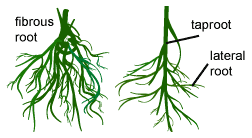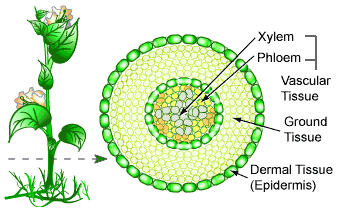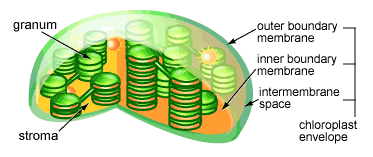CAPTURING THE SUN: AN EXPLORATION INTO THE WORLD OF PLANT SCIENCE
(August 2003)
Plants rank as one of the most important species on our planet. As primary producers, plants are at the base of the food chain for most terrestrial ecosystems, with nearly all land animals depending on them on as a source of food. The significance of plants as the basis of the food chain has not gone unnoticed by humanity. As a result, the field of plant science has blossomed with intellectual gains. Our understanding of the structure of plants, how they function, and what they do for us, growing daily. This article is an introduction for anyone interested in plants and the extensive study that has gone into better understanding them. It explores such topics as what a plant is, how it grows and is organized, the many uses of plants, as well as jobs available in the field.
What is a plant?
A plant is a form of life than can produce its own energy from the sun allowing it to live solely on inorganic matter. There are many features found in plant cells that distinguish them from animal cells. One of the most obvious being chloroplasts—organelles that contain an important pigment called chlorophyll. It is this pigment that gives plants their green color as well as being the location within the chloroplast responsible for producing food energy from sunlight. Further details on chloroplasts and chlorophyll are discussed below under the topic of photosynthesis.
Why all the Interest in plants?
Since plants are unable to move freely and lack the sophisticated sensory organs that animals possess, what makes them such an interest? Why have thousands of people dedicated their lives to understanding how work?
Quaintly—it is their ability to use the sun, which we jealously lack, which draws our focus. Life needs energy and plants can produce it. Many people would like to know how?
First Concept to Learn: Plant Structure
All plants have three basic organs: roots, stems, and leaves. All three organs consist of dermal, vascular and ground tissue. Each of which can be further divided into three basic cell types called parenchyma, schlerenchyma, and colenchyma cells (all discussed below).
Roots are the base of all plants and are generally found beneath the surface. They function to anchor the plant into the ground and to absorb water and minerals that help the plant to grow. Roots are additionally important in the storage of food and can be seen in two different systems: fibrous roots and taproots (see Figure 1). The fibrous root system is made up of many little roots of equal thickness extending out from one point, creating a matted tangle of roots. A fibrous root is commonly observed in grasses. Taproots, however, stem from one larger root that can then break down into smaller lateral roots extending from the central taproot. The taproot is capable of storing food and can be found in weeds such as dandelions as well as root crops, like potatoes and carrots. Unlike fibrous roots that are mainly found up near the surface, taproots are capable of extending down deeper into the soil.

Leaves and stems are the other two important organs and comprise what is known as the shoot system. The entire shoot system is found above ground and serves two main functions. The first function is to produce food. This is observed in plants that carry many leaves allowing for more photosynthesis. For it is the leaves that comprise the main photosynthetic organs of most plants, although green stems are also capable of photosynthesis. The second function of the shoot system is to be reproductive. In which case, the stems carry more flowers, which contain the reproductive organs in plants.
Each leaf, root, and stem also has three tissue systems (see Figure 2). The dermal tissue, also referred to as the epidermis, is the skin of the plant and functions to protect the plant from potentially harmful effects. Plants are exposed to many potential hazards from environmental stresses, from drought, cold, and UV radiation, to mechanical stresses like pathogens and insects that can cause damage to the plant. The protective nature comes from a thin cuticle surrounding the epidermal cells. The cuticle is a non-cellular protective layer containing wax and other components giving the plant its protective coating. The next tissue system includes vascular tissue, which functions to transport materials that are essential for plant survival, between the roots and shoots. It is found throughout the plant and can be divided into two types: xylem and phloem. The xylem is found in the innermost ring of the vascular tissue, where it functions to transport water and minerals from the roots to the shoots. In contrast, the phloem surrounds the xylem and transfers food produced from the leaves back down to the roots. Everything else comprises the last tissue type and is known as the ground tissue. It has many functions including photosynthesis, storage, and support.

Three different cell types make up all of the plant tissues and organs described above. Each of which has a different function that helps the plant survive. Firstly are parenchyma cells, which carry out most of the metabolic functions of the plant. These functions include the synthesis and storage of various organic products, which are food sources for the plant. The second type of cell is the collenchyma cell that functions primarily in support of young parts of the plant shoot. They are living, functioning cells that elongate and grow with the organs they support. Finally, the schlerenchyma cells serve as further support, however these cells are unable to elongate and are only found within non-growing regions of the plant. These cells have thicker cell walls that contain lignin for extra support. Lignin is a polymer found within the cell wall surrounding plant cells giving them the extra support they need. It is a combination of these cells that make up the plant and work together to carry out all its cellular functions.
Second Concept to Learn: Creating Chemical Energy from the Sun
Photosynthesis is the process by which plants and some bacteria use energy from the sun to make chemical energy that can be stored in sugars and other organic molecules. It is the primary source of food to all plants, which go on to provide food to higher organisms including humans. As mentioned before, photosynthesis occurs in the chloroplasts of plant cells. These watermelon-like structures are distributed throughout the cytoplasm and range from about 4-7µm in size (see Figure 3). They contain a double membrane that surrounds the chloroplast, with an intermembrane space between. On the inside of the chloroplast is another membrane (the thylakoid membrane) that is surrounded by a thick fluid called the stroma. The thylakoid membrane forms plates that can stack within the chloroplasts to form a structure called a granum. Within the thylakoid membrane of these plates is the chlorophyll that absorbs the sun’s light and converts it to energy that can be stored as food.

A plant needs light, carbon dioxide, and water for photosynthesis to occur. The process involves two basic sets of reactions that take place in the chloroplast. The first includes the light reactions. These reactions involve the absorption of light energy by chlorophyll. The absorbed energy is then converted into chemical energy in the form of adenosine triphosphate (ATP), a molecule that is the primary energy source in all cells (due to its ability to carry a lot of energy in it’s phosphate bond). Another important source of chemical energy is nicotinamide adenine dinucleotide phosphate (NADP+), which acts as a hydrogen acceptor storing its chemical energy in a hydrogen bond to form NADPH. These compounds transport electrons, in the form of energy, to the second set of basic reactions, the dark reactions. These reactions occur in the stroma and convert carbon dioxide into organic compounds by utilizing the energy produced during the light reactions. This phenomenon occurs through a cycle known as the Calvin Cycle, which does not directly require sunlight to function (hence their often being referred to as the dark reactions). Organic compounds produced in the Calvin Cycle include sugars, the major food source of plants. Many organisms cannot produce these organic compounds on their own. Therefore, they are reliant on plants to produce their sugars, making a plant’s ability to photosynthesize a building block for the sweet complexity of life.
Third Concept to Learn: Plant Growth
To grow is a natural process and is seen in all animals as they mature. Plants are no different—they are capable of growing and reproducing like any animal. This section discusses the basic mechanisms involved in how a plant grows and develops. A basic understanding in this area has allowed botanists to apply their knowledge to artificial plant growth, enabling us to grow more plants at a faster rate. A few of these fascinating applications will be discussed later, however, to understand them better, a basic understanding of how plants naturally grow and reproduce is wise.
Plant growth occurs at a region containing embryonic tissue, which allows cell division to occur. This region is known as the meristem. Embryonic tissue found at the tips of roots and in the ends of shoots is a form of meristem, called the apical meristem. It is responsible for a plants growth in length. Elongation of this kind is called primary growth and can only occur at the apical meristem. In herbaceous plants, this is the only kind of growth. However, in woody plants (i.e. trees) there is also a secondary growth, where the roots and shoots get thicker and tougher to allow for more water and nutrients to be absorbed from the soil.
As a plant gets bigger, it also requires more food. Since food is obtained through photosynthesis, which mainly occurs in the leaves, the plants will need to produce more leaves to grow further. Some plants have fewer and broader leaves, which enable them to capture more sunlight, while others contain many smaller leaves to do the same thing. Both types of plants require a greater surface area for their leaves to collect more sunlight, allowing for more photosynthesis and eventually more food. Plants have adapted different ways of obtaining the light they need. An example is observed in the trees found in rainforests. There, all the green leaves are seen in the canopy far above the dark surface. Leaves near the earth’s surface don’t receive the light they require for photosynthesis and therefore have no need to be there. This results in most of the green being far above the ground, closer to the light source.
Uses of Plants
Understanding how a plant grows lets us conceptualize how and why plants are used. They come in many shapes and sizes, each giving us different things—from the food we eat, to the wood we burn, the paper we write on, and the clothes we wear.
One of the most important uses of plants is in the carbohydrates they produce. Carbohydrates make up a large part of the foods we eat including pasta, bread, breakfast cereal, rice, and desserts made from grains. Carbohydrates can also be converted to fats or sugars, all constituting a large proportion of our diet. It is these important sources of food that provide us with the energy we need. In fact, plants are the basis of the entire food chain. Feeding our constantly growing population is a concern and plant science has contributed valuable techniques to enable the agricultural industry to meet the demand made by an expanding population. A few of these techniques are discussed later in the next section.
A second example of plant uses is the production of wood. This material, found in the trunks of trees, can be cut into lumber for building houses and ships. It can be burned as fuel for heating homes and cooking food, as well as made into materials such as nylon and rayon to be worn as clothing. Furthermore, wood fibers can come together to form sheets of paper. The many uses of wood have made the forest industry an important economic factor in the world. In Canada, nearly one million hectares of forest is harvested each year, employing close to 300 thousand Canadians and making forestry one of the largest contributors of our gross domestic product (Statistics Canada, 2002).
Not only do we personally benefit from plants but the environment around us also benefits from the existence of plants, using them as a fundamental resource for the health of the biosphere. Plants are one of the sources responsible for replenishing the earth’s oxygen supply, preventing soil erosion, slowing down wind movements as well as working to cool the atmosphere.
As our knowledge of plants has increased, we have learned of many other ways to use plants and incorporate them into more than just our diet. These techniques all fall under a new field called plant biotechnology. This field combines disciplines such as plant science and genetics, and has allowed us to modify our crops to give us things like bigger and juicier fruits. Plant biotechnology is growing weekly and opportunities in this field are opening many eyes.
Jobs in Botany
Plants have been a constant source of business and employment throughout human history. For thousands of years people have survived by growing and selling crops. In some countries this is still the case, but many developed countries have discovered a new field involving complex genetics allowing them to use new approaches to growing their crops.
As mentioned above, this new field is often referred to as plant biotechnology and involves genetically modified organisms in both agriculture and industry. This field involves designing new methods for growing crops and selecting them for desired traits. Some of these techniques include cell culture in which plants are produced asexually and in a liquid medium. This allows scientists to grow more plants without waiting for a plant to reach its reproductive age. Cell culture can be complemented with another area of interest called transgenics, where scientists can genetically modify plants to express desired traits. Many of the crops we eat today are transgenically created to produce a desired color or size, an example being corn. The options in this field seem endless, so that plant biotechnology is now allowing humanity to meet the needs required by the industry. The development of this field has occurred with much debate on its necessity, but it has never been truer that knowledge of plant science and agriculture is a requirement of the argument for or against.
All of this is making the study of plants, usually referred to as botany, an exciting field to be involved in. There are courses available in virtually all universities and colleges to educate people on plant structure and function. After a basic understanding of the fundamentals of botany is obtained, many opportunities in plant biotechnology are opened up—from positions in agricultural industry, university research, to the many biotechnology firms working with plants. Today, many individuals are taking their knowledge of plants and proceeding to apply it to new methods of cell growth that can be used in industry, placing botany on the cutting edge of biotechnology.
Conclusion
In understanding more about the role of plants in our society one can understand why the study of plants is so important. In recent years many developments have arisen allowing us to improve our crop quality and quantity. In the next few articles you will learn more about these modern technologies including new methods of producing plants, ways of altering plants to give us the features we want, and ways of manipulating plants to last longer on our shelves. Techniques are constantly being discovered and there seems to be no limit to what we can do with our plants.
Texts consulted and additional readings
1. Raven P., Evert R., Eichhorn S. (1999). Biology of Plants, 6th ed. Freeman and Company/Worth Publishers. New York, New York.
2. Campbell N, Reece J. (2002). Biology, 6th ed. Pearson Education, Inc. San Fransisco, CA.
(Art by Jane Wang – note that high res versions of these image files are available here)